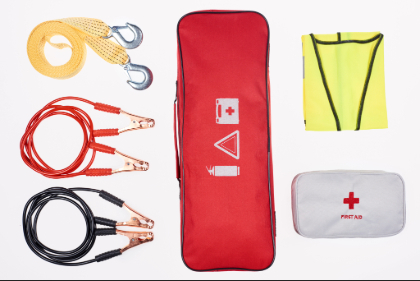INDEPENDENT DEALER
Ann Arbor, MI | (702) 561-3706
Dwight Smith
OUR BLOG
09/08/2025
In the blog post below, Dwight Smith in Ann Arbor, MI, knows what to keep in a car emergency kit and dishes out their secrets. Read on and build the right kit ASAP!

Don't settle for ordinary motor oil when your engine deserves extraordinary protection that prevents problems and extends component life. Contact authorized AMSOIL dealer Dwight Smith in Ann Arbor, MI, at (702) 561-3706 or shop AMSOIL's online store to explore synthetic products engineered for maximum protection, superior performance, and extended service life that keeps your vehicle running strong for years to come.
The Foundation: Basic Safety Equipment
Every driver should know what to keep in a car emergency kit for maximum safety and peace of mind. Start with these fundamental items that address the most common roadside emergencies.
- Reflective triangles or flares are your first line of defense, alerting other drivers to your presence. Place them 100 feet behind your vehicle to give approaching traffic adequate warning. A high-visibility safety vest ensures you're seen when working around your car, especially during low-light conditions.
- Keep a reliable flashlight with extra batteries in your kit. LED flashlights offer longer battery life and brighter illumination than traditional bulbs. A multi-tool with pliers, screwdrivers, and a knife can handle minor repairs and adjustments.
Jump-Starting and Tire Emergencies
Dead batteries and flat tires rank among the most frequent roadside problems. Heavy-duty jumper cables rated for at least 400 amps can restart your engine when the battery fails. Consider investing in a portable jump starter for added convenience and safety.
A complete tire repair kit should include a spare tire, jack, lug wrench, and tire pressure gauge. Don't forget a tire sealant for temporary repairs to small punctures. Check your spare tire's pressure monthly. Remember, a flat spare tire won't help when you need it most.
Weather-Specific Emergency Supplies
Understanding what to keep in a car emergency kit means preparing for your region's weather challenges. Winter drivers need additional items like an ice scraper, snow shovel, sand or kitty litter for traction, and warm blankets.
During summer months, extra coolant and water become crucial. Engine overheating increases significantly in hot weather, and having the proper fluids can prevent costly damage. Pack electrolyte drinks and high-energy snacks to maintain strength during lengthy roadside waits.
Communication and First Aid Essentials
Your emergency kit should include a fully charged portable phone charger or power bank. Cell phone batteries drain quickly in emergency situations, and maintaining communication with family and emergency services is vital.
A basic first aid kit addresses minor injuries that might occur during roadside repairs. It should include bandages, antiseptic wipes, pain relievers, and any personal medications you might need. In a waterproof container, add emergency contact information and your insurance details.
Reach out to Dwight Smith in Ann Arbor, MI, at (702) 561-3706 or stop by the AMSOIL web store to find synthetic motor oils, gear lubricants, and specialty fluids that deliver professional-grade protection for your valuable vehicle investment.
Advanced Preparedness Items
Experienced drivers often expand their kits with additional tools and supplies. Duct tape handles temporary fixes for loose parts or damaged hoses. A small fire extinguisher rated for automotive use can prevent small fires from becoming major disasters.
Consider packing non-perishable food items like energy bars and bottled water. During extended waits for assistance, especially in remote areas, these supplies maintain your comfort and energy levels.
Choose Professional-Grade Protection
AMSOIL's comprehensive product line includes specialized lubricants for extreme conditions. From transmission fluid to differential oil, having the proper fluids available can sometimes get you back on the road safely.
Maintenance and Storage Tips
Store your emergency kit in a waterproof container in your trunk or cargo area waterproof container. Review and update supplies every six months, replacing expired items and checking battery levels. Rotate food and water supplies to ensure freshness. While power banks can be safely stored in a vehicle if kept away from direct sunlight and extreme temperatures, it’s best to refrain from keeping them inside the car to prevent the possibility of fire hazards, so if you can carry these items with you, do so. Test your equipment periodically to ensure everything works properly. Practice using your jack and changing a tire in your driveway; emergencies aren't the time to learn these skills.
Creating Your Action Plan
Knowing what to keep in a car emergency kit is only half the battle. Develop a plan for different emergency scenarios. Know who to call first, understand your location-sharing options, and familiarize yourself with your insurance company's roadside assistance procedures.
Remember that roadside emergency kit essentials should match your driving patterns and regional conditions. Frequent highway travelers need different supplies than city drivers, and seasonal adjustments ensure year-round preparedness.
The most critical safety equipment isn't in your emergency kit; it's the synthetic oil protecting your engine from unexpected failures and costly breakdowns. Contact authorized dealer Dwight Smith in Ann Arbor, MI, at (702) 561-3706, or visit AMSOIL's online store to order AMSOIL Signature Series 5W-30 100% Synthetic Motor Oil.
CONTACT